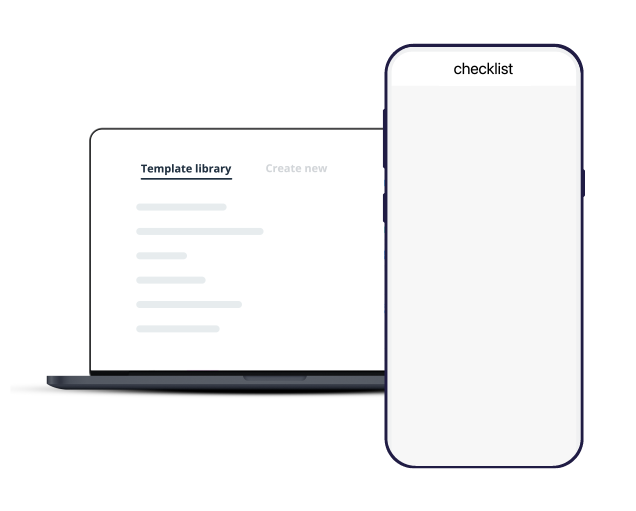Use our incident report checklist template as a starting point to customize yours to fit your company.
Incident Report Checklist

Make work flow with Connecteam’s digital forms & checklists
- Easily create digital forms and checklists for any task your team needs to complete on the job
- Boost accountability by having employees add a signature, image, or location stamp
- Save time by choosing from a variety of ready-made templates
- Instantly receive your team’s submissions and share reports within your organization
- Use AI to convert PDFs, Excel files, or images into digital forms in seconds—no manual work needed

Incident Report Checklist
Ensuring the safety and well-being of all personnel within the construction industry is of paramount importance.
Construction sites can be dynamic environments with inherent risks that demand vigilance and proactive measures to prevent accidents and incidents.
When unforeseen events occur, promptly documenting and investigating them is vital for learning, improving safety practices, and preventing similar occurrences in the future.
This Incident Report Checklist is specifically designed for professionals in the construction industry to comprehensively capture incident details, assess the severity of the event, analyze root causes, and implement effective corrective and preventive actions.
It serves as a structured framework to gather accurate and relevant information, enabling thorough incident investigations and valuable insights for continuous improvement.
Date: [Date of incident]
Incident ID: [Assigned Incident Identification Number]
1. Incident Details:
– Date:
– Time:
– Location (Specific area within the construction site):
– Project Name:
– Phase of the Project (if applicable):
2. Incident Reporting Information:
– Name of Person Reporting:
– Designation:
– Contact Number:
– Email:
– Name of Supervisor/Foreman (if applicable):
3. Incident Type:
[ ] Fall from Height
[ ] Struck-by/Struck-against
[ ] Caught-in/Between
[ ] Electrical Incident
[ ] Slip, Trip, and Fall
[ ] Equipment Malfunction
[ ] Fire/Explosion
[ ] Hazardous Material Exposure
[ ] Near Miss/Close Call
[ ] Other (Specify):
4. Incident Description:
[Provide a detailed narrative of what happened before, during, and after the incident. Include the sequence of events, weather conditions, and any contributing factors. Use additional sheets if needed.]
5. Safety and Health Implications:
– Were there any injuries or illnesses resulting from the incident? [Yes / No]
– If Yes, describe the nature of injuries or illnesses:
– Was medical attention required? [Yes / No]
– If Yes, describe the medical treatment provided:
– Note any potential long-term health implications resulting from the incident (e.g., exposure to hazardous materials):
6. Property Damage Assessment:
– Describe any damage to construction equipment, tools, or materials (if applicable):
– Estimate the cost of repair or replacement (if available):
7. Witness Statements:
[Record statements from witnesses and include their perspective on the incident. Use additional sheets if needed.]
8. Root Cause Analysis:
– Primary Cause:
– Contributing Factors:
– Root Cause Analysis (RCA) – [Describe the root cause using techniques like the 5 Whys, Fishbone diagrams, etc.]:
9. Corrective Actions Taken:
[Outline any immediate actions taken to address the incident and mitigate its impact. Include any first aid or emergency response measures conducted on-site.]
10. Preventive Measures:
[List long-term preventive actions to avoid similar incidents in the future. Specify responsible personnel and include the importance of ongoing safety training and communication.]
11. Incident Investigation Team:
– Lead Investigator:
– Team Members:
12. Management Notification:
– Was management notified about the incident? [Yes / No]
– If Yes, provide the names and designations of notified management personnel:
13. Regulatory Compliance:
– Are there any legal or regulatory compliance issues associated with the incident? [Yes / No]
– If Yes, specify the relevant authorities or regulatory bodies informed:
14. Follow-up and Monitoring:
– How will the effectiveness of corrective and preventive actions be monitored?
– Set a timeline for follow-up reviews and assessments to track improvements:
15. Incident Report Approval:
– Name and Signature of the Person Approving the Incident Report:
16. Distribution and Archiving:
[List the recipients who will receive copies of the incident report. Ensure secure archiving for future reference, audits, and insurance purposes.]
17. Additional Notes/Attachments (if applicable):
[Use this section for any additional information, diagrams, or photographs related to the incident.]
Please submit this Incident Report Form to the relevant authorities and designated personnel promptly after the incident occurs. The information provided will be crucial for continuous improvement, safety measures, and accident prevention in the construction industry.
Choose Connecteam, the #1 Choice for Construction Companies
Streamline incident report forms with Connecteam and let your team effortlessly fill out incident reports on their smartphones, ensuring timely and accurate documentation.
Say goodbye to manual processes and embrace our customizable digital forms & checklists that enhance communication and safety.
Connecteam’s user-friendly mobile app allows your team to complete incident reports on the go, reducing paperwork and saving time. Stay on top of safety concerns with real-time data and instant notifications to relevant personnel.
Get started with Connecteam for free today and simplify your construction site’s incident reporting process.
Watch the video below to see it in action:

Ready to boost your efficiency with our pre-made templates?